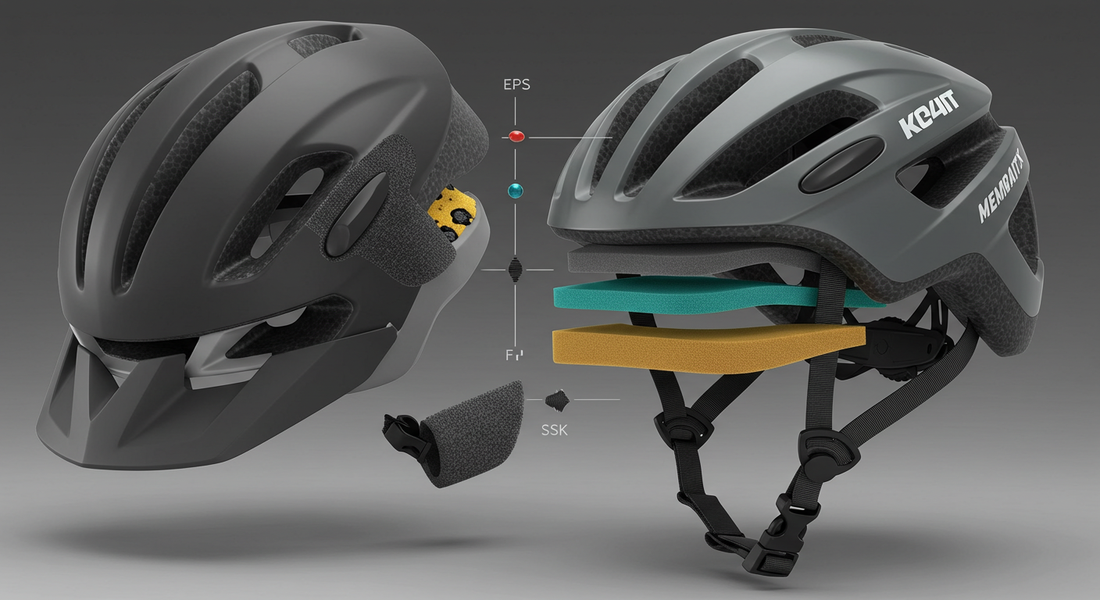If you love cycling or ride it often, you must have a good helmet. In case of a crash or fall, your cycling helmet will protect you against everything from minor facial injuries to death. Before buying a helmet, check that its materials meet safety standards and ensure adequate impact resistance. Manufacturers have introduced a few newer materials to maximize rotational impact protection and energy absorption. Keep your helmet clean to maintain its effectiveness.
What are bike helmets made of? Cyclists pondering this question must keep reading to learn more about helmet anatomy.
Common Materials:
Helmets are designed using a lot of different materials. Common material choices include thermoplastics like polycarbonate and ABS or composites like carbon fiber and fiberglass. Now, what should you do? You must make sure that the helmet material used in its design is good enough to protect from head injuries and other serious impacts. Let's delve deep to know more about materials:
Thermoplastics:
A helmet design is not enough to consider. The helmet material shows its effectiveness. Different helmet types are made with unique materials. PC (Polycarbonate) is a thermoplastic used in the outer shell of a helmet. It is known for durability, high impact resistance, and resistance to cracking. It's mostly used in heavier-duty helmets. This material is preferred to protect against chemical exposure.
ABS (Acrylonitrile Butadiene Styrene) is also a commonly used material suitable for multiple applications. It is a lighter and more affordable alternative to other helmets. This material can be used in construction helmets and road bike helmets. It offers chemical resistance and decent impact resistance. Both of the thermoplastics provide higher flexibility.
Composites:
The helmet's outer shell is made up of either impact-resistant thermoplastic or composite material. The inner shell of expanded polypropylene (EPP) or expanded polystyrene (EPS) ensures shock absorption. Fiberglass is a strong, moldable composite material. It is resistant to high temperatures and provides high impact resistance. A fiberglass helmet is best for demanding construction environments.
Carbon fiber is a lightweight but very strong composite material. It lowers neck fatigue and offers superior protection with its amazing strength-to-weight ratio. This top-tier helmet is best in high–performance applications and racing. Kevlar is a high-strength and flexible composite material. When combined with fiberglass or carbon fiber, they create lightweight helmets. Kevlar helmet is used in modern helmets for enhanced protection.
Safety Standards:
What are helmets made of? At this point, you have learned it well. Some safety standards must be considered while designing a cycling helmet. The best motorcycle helmet of the right size and fit, meeting the standards, will ensure riders' safety. The following are some given:
- Impact Resistance: Cycling helmets are designed to protect the head during crashes or accidents. So, it must absorb impact energy and distribute it equally.
- Rotational Impact Protection: It is still rare, but some standards are concentrating on decreasing rotational head acceleration. This will ultimately reduce brain injuries.
- Penetration Resistance: Helmets must be able to bear piercing forces. So, they must meet such a safety standard.
- Material Performance: Helmets must be made up of those materials that maintain their structural integrity and resist impact forces.
Material Comparisons:
We have explored all the helmet parts' names, features, and safety standards. Now, here is a comparison between different helmet materials.
- Polycarbonate vs. ABS:
- Polycarbonate provides durability and better impact resistance than ABS. But ABS is a lightweight and cheaper option.
- Fiberglass vs. Carbon Fiber:
- Fiberglass is more cost-effective and lighter than carbon fiber. But carbon fiber offers energy absorption and superior strength.
- Thermoplastics vs. Composites:
- Thermoplastics are usually isotropic, which means their properties are consistent in all directions. While composites can be anisotropic, with changing properties depending on the fiber orientation.
Innovations:
Innovations introduced to helmets are the use of advanced composites. Materials such as Kevlar, carbon fiber, and other composites are continuously refined and developed. This advancement will boost helmet weight, strength, and impact resistance.
Energy Absorption Systems, an innovation in cycling helmets, incorporates new technologies. The purpose of it is to enable helmets to better absorb energy during forceful impact with specialized structures and foams.
A few helmets are now using a biomimetic Structure. These bio-inspired designs are introduced to improve their energy absorption and protective capabilities.
Maintenance:
Keep your helmet clean. Regular cleaning will increase the lifetime of your helmet and help you better maintain it. Remove dirt, sweat, and debris by washing it with water and soap. But you must avoid harsh chemicals. Limit the use of solvents or abrasive cleaners that could destroy the helmet's liner or shell. Make worn-out components replacement habit. You can replace harnesses and sweatbands. This will prolong the helmet's life and keep it hygienic. Always store the cycling helmet in a dry, cool place after using it.
Conclusion:
Different types of helmets are designed with a variety of materials. The material makes the helmet highly impact-resistant, flexible, and durable. Choose your right size and fit, and have a safe ride. Keep your helmet clean to keep it going for a long time. If you want to learn more, read our introduction to cycling helmets.
